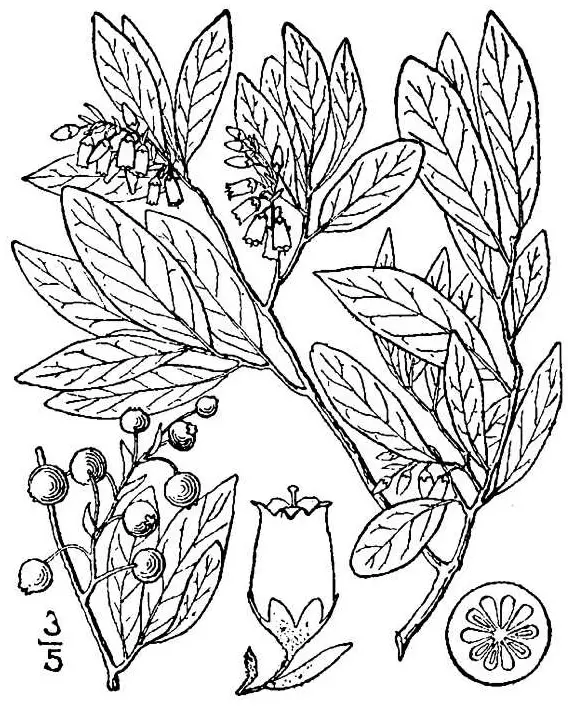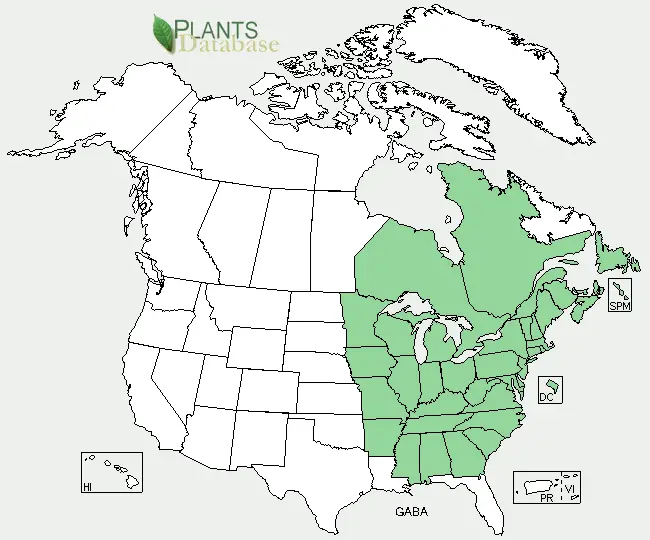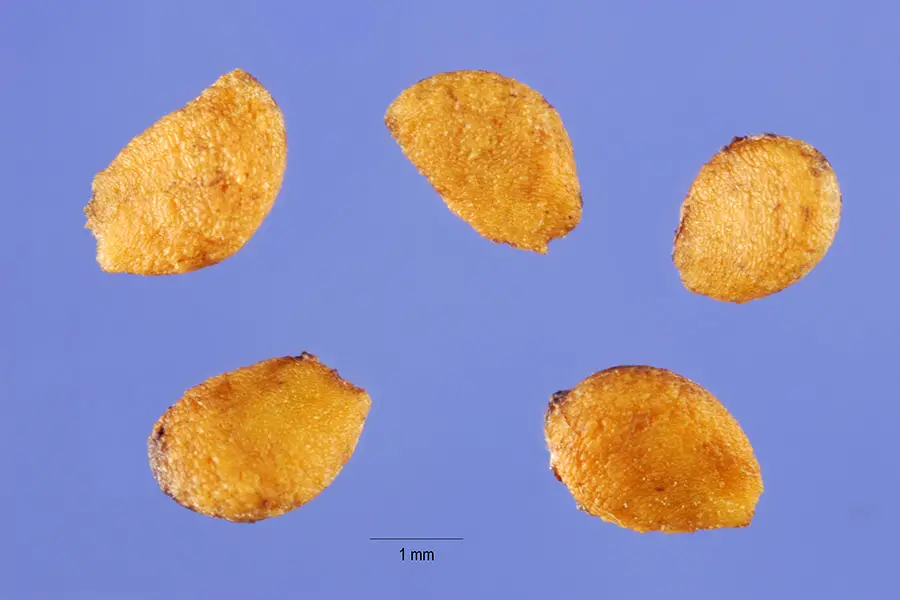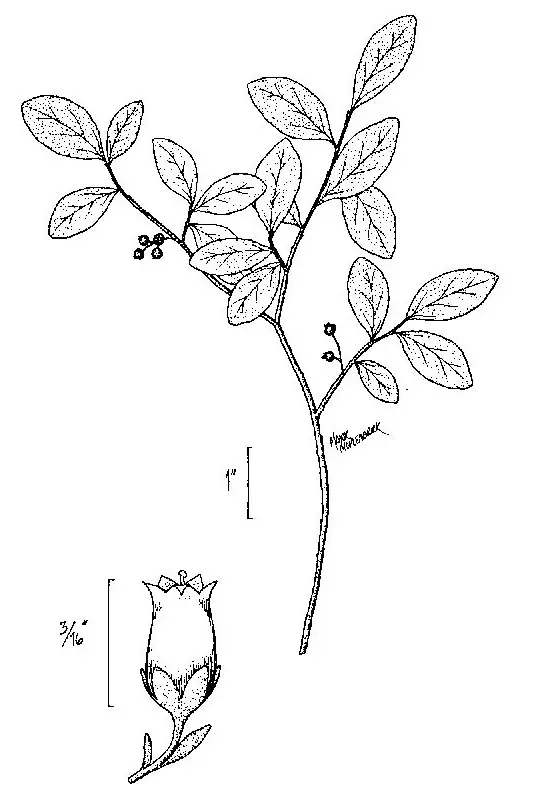
Search Wild Foods Home Garden & Nature's Restaurant Websites:
Huckleberry (Black)

Huckleberry drawing. (USDA-NRCS PLANTS Database / Britton, N.L., and A. Brown. 1913. An illustrated flora of the northern United States, Canada and the British Possessions. 3 vols. Charles Scribner's Sons, New York. Vol. 2: 696)
(NOTE: If you are not interested in Huckleberries, but just finding and using them, try going to the Nature's Restaurant Online site for Huckleberry.)
Black Huckleberry: (Gaylussacia baccata). There are plants that are in the Vaccinium Genus that are also called Huckleberries, though that would technically make them either a Blueberry or Bilberry. This entry is only for the Gaylussacia Genus, the Gaylussacia baccata specifically.
There are more Huckleberries than just the Black Huckleberry, start here to find out more about this group of berries.
Good for eating fresh or cooked, but there are two things about this one. The seeds are bigger than a similar sized Blueberry, and the taste, in my opinion, is not quite as good, but that could just be me or a regional variance. If given the choice, I'll take Blueberries. They seem to occur in more or less the same places and habitats as Blueberries.
There are two advantages to growing this over the Blueberries - one, this plant once established will aggressively form what are known as clonal colonies. That is, it will send up new plants from the roots forming areas of Huckleberries. This makes growing this plant easy, and a good choice if you have a larger area where the soil is acidic, but not as good quality as you would like for Blueberries. For instance, if you have good, acidic soil, but it is full of rocks, this plant will just keep spreading around, saving you from having to work with rocky soil. The other advantage this has over growing Blueberries is it will do fine in partial shade, whereas Blueberries need full to almost full sun.
For growing from seed, see the section on growing Blueberries from seed here. You could also try planting the seeds directly in the fall or early spring. This is a slow plant to get going by seed. This is an easy one to transplant. Just do it in the spring after the ground has thawed, or in the fall before the ground freezes. Read over about the soil conditions in the Blueberry section to prepare the ground for this plant.
Description:
- USDA Plant Hardiness Zone: 3-7 (More information on hardiness zones).
- Soil pH: 5.0-6.5
- Plant Size: Up to 1 meter (3 feet) tall
- Duration: Perennial Shrub that will form clonal colonies
- Leaf Shape: Generally Ovate to Obovate
- Leaf Phyllotaxis (Arrangement) on branch: Alternate
- Leaf Size: 2.5-5.7 cm (1 to 2 1/4 inches) long and 1.3-2.5 cm(1/2 to 1 inch) across
- Leaf Margin: Entire (smooth edged)
- Leaf Notes: Small yellow dots (glands) on both sides of the leaves, very short thin stem, turn red in fall and stay on plant longer than most deciduous trees and shrubs.
- Flowers: Form on a raceme coming from the leaf axils (where leaf stem meets twig), blooms from late spring to early summer, reddish to pinkish, hang down from stems, urn or bell shaped about 7-9 mm (1/3) inch long and about 6-7 mm (1/4 inch) across
- Fruit: 7-9 mm (about 1/3 inch) diameter, blue-black when ripe, green when unripe, sweet, juicy with 10 seeds per fruit, similar looking to a Blueberry, but taste is a little different. Seeds are bigger than Blueberry seeds
- Bark: Stems that are young can be yellow-green to red-brown with or without hairs. Older stems are light grey to blackish.
- Habitat: Sandy, rocky areas, root system can withstand forest fires and resprout quickly. Often found in boggy areas in the drier parts, does not like alkaline soils such as those over limestone, does well in acidic soils that are thin over bedrock and will form clonal colonies in these areas where the soil is too thin for large trees
Web Resources:
- Recipe search on the web here (Google search) and here (Bing search).
- Pictures on the web here (Google images) and here (Bing images).
- Interactive USDA distribution map and plant profile here.
- The Biota of North America Program (BONAP) distribution map here. BONAP map color key here.

Black Huckleberry: (Gaylussacia baccata) range. Distribution map courtesy of U. S. Department of Agriculture (USDA Natural Resources Service) and used in accordance with their policies.

Huckleberry seeds. (Steve Hurst, hosted by the USDA-NRCS PLANTS Database)

Huckleberry drawing. This simplified drawing clearly shows leaf arrangement and flower structure. (USDA-NRCS PLANTS Database / USDA NRCS. Wetland flora: Field office illustrated guide to plant species. USDA Natural Resources Conservation Service.)
Search Wild Foods Home Garden & Nature's Restaurant Websites:
Share:
Why does this site have ads?
Originally the content in this site was a book that was sold through Amazon worldwide. However, I wanted the information to available to everyone free of charge, so I made this website. The ads on the site help cover the cost of maintaining the site and keeping it available.
Google + profile
